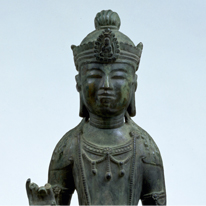Past Exhibitions
- Feature Exhibition: An Ancient Temple of the San'in Region: The Treasures of Gakuen-ji Temple in Shimane
- January 2, 2015 - February 15, 2015
In 2012, the Kyoto National Museum presented The Grand Izumo Exhibition, a special exhibition commemorating the 1300th anniversary of the ancient chronicle Kojiki as well as the major rebuilding of Izumo Taisha Shrine. Izumo is home to the grand shrine and is a place often mentioned in ancient mythology, for which reason it is closely associated with Japan's native Shinto faith. The 2012 Izumo exhibition, however, examined not only the Shinto culture of this region but also its Shinto–Buddhist syncretic religion as well as its Buddhist culture from ancient times through the medieval period. With the generous cooperation of numerous shrines and temples as well as the Shimane prefectural government and the Shimane Museum of Ancient Izumo, the museum was able to introduce the spiritual culture of this region to numerous visitors.
While The Grand Izumo Exhibition may have done something to break down the perception of Izumo as a purely Shinto area, it by no means penetrated the depths of Buddhism in Sai'in, the region in which Izumo is located. This exhibition of treasures from Gakuen-ji helps to rectify this deficit.
Gakuen-ji is a Tendai sect temple in Shimane prefecture. It is hailed one of the sacred places in Japan in a late Heian period (circa 1180) anthology entitled Ryōjin hishō (Songs to Make the Dust Dance on the Beams), which was selected by Retired Emperor Goshirakawa. This reference tells us that by the late twelfth century, Gakuen-ji was already famous as a sacred site and temple among the people of Kyoto.
Among the treasures preserved over the centuries in Gakuen-ji is a Standing Avalokiteśvara Bodhisattva sculpture (Important Cultural Property) with an inscription dating it to 692, as well as a ninth-century finial from a priest's staff (not on view), which was discovered on temple grounds in a cave devoted to the mountain deity Zao Gongen. Such works tell us that Gakuen-ji was established as a monastery from the early part of the Heian period (794–1185). The name Gakuen-ji doesn't appear in writing, however, until the Kamakura period, when it appears in the 1213 Mandate to Gakuen-ji from the Administrative Office of Mudō-ji on Mt. Hiei on view in this exhibition. This document states that, upon the order of Retired Emperor Gotoba, the government official in Izumo province must allocate a large parcel of land to Gakuen-ji, to be divided into two precincts. The North and South Gakuen-ji precincts will be under the administration of the temple Mudō-ji on Mt. Hiei in Kyoto, to which each precinct must submit half the annual rice taxes.
With this mandate, Gakuen-ji effectively became a branch temple of Mudō-ji and an official part of the network of Tendai sect temples. Thereafter, Gakuen-ji joined Daisen-ji and Sanbutsu-ji in Hōki province as one of the three major temples of the San'in region.
This exhibition features various artworks from the temple including Buddhist and Shinto sculptures, some designated as Important Cultural Properties of the national or prefectural government. Most of these works are on view at the Kyoto National Museum for the first time, allowing us to consider Tendai Buddhist connections between Kyoto and Izumo in ways that were not covered in The Grand Izumo Exhibition. At the same time they reveal to us the fascinating history and appeal of Gakuen-ji Temple.












